-
If you are posting pictures, and they aren't posting in the correct orientation, please flush your browser cache and try again.
Edge
Safari/iOS
Chrome
You are using an out of date browser. It may not display this or other websites correctly.
You should upgrade or use an alternative browser.
You should upgrade or use an alternative browser.
New blank canvas farm tour in Northern MO
- Thread starter Hoytvectrix
- Start date
Hoytvectrix
5 year old buck +
I wasn't planning on drilling the switch in and was planning on frost seeding. My thought was ease of spreading this winter and also I was hoping to get it up as soon as possible next year. The other benefit is the in-field cold stratification this winter (although it sounds like this is less of a concern with RC Big Rock). Would you still advocate for late spring drilling over frost seeding?Looking good and I know the feeling of weak fall plots. After years of fall plot failures we waved the white flag and converted our last few plots to clover/chicory.
Some guys are having great luck drilling RC Big Rock in June and even later, on well prepped ground. I think you'll have much better results than frost seeding.
Brian662
5 year old buck +
The biggest advantage to the RC line is that they don't need to be cold stratified. The biggest benefit of that is the ability to kill the first or second flush of weed/grass growth in April/May before seeding.I wasn't planning on drilling the switch in and was planning on frost seeding. My thought was ease of spreading this winter and also I was hoping to get it up as soon as possible next year. The other benefit is the in-field cold stratification this winter (although it sounds like this is less of a concern with RC Big Rock). Would you still advocate for late spring drilling over frost seeding?
I have had luck broadcasting seed (not frost seeding) onto bare soil in May. I prefer moist soil and day after a rain and then cultipacking the seed to press it into the soil. Spray simazine or atrazine and let it go, will be 6-8' in the second year without issue doing this method.
MN Slick
5 year old buck +
I wasn't planning on drilling the switch in and was planning on frost seeding. My thought was ease of spreading this winter and also I was hoping to get it up as soon as possible next year. The other benefit is the in-field cold stratification this winter (although it sounds like this is less of a concern with RC Big Rock). Would you still advocate for late spring drilling over frost seeding?
Check out the Switchgrass post on Iowawhitetail https://iowawhitetail.com/community/forums/dbltrees-habitat-corner.45/. Iowabowunter1983 has been doing it will great success and advocates for Duracor herbicide as well. He has a video of August planting RC that looks incredible. I think Higgins is waiting until soil temps up now as well and is drilling it in. I would do it for sure since you have a drill. My frost seeding attemps have failed down there.
Hoytvectrix
5 year old buck +
Reposting this here from another thread just to have it all in one place.
This is a hunt I had on November 10th at my new(ish) farm in northern MO. This is a buck we had very little history of since we bought the farm last year. Just a couple of trail camera photos/videos in 2023. I did film him being an opportunistic satellite buck watching another bigger buck with a doe during the firearm season last year. I very briefly thought about taking him but was waiting on the buck with the doe that year and I never got a shot at the bigger one or any other mature bucks that year in archery or firearm seasons.
We have a great ridgetop plot that is a saddle between two ravines of cover on this farm. It hunts very well if we can access it cleanly and have any kind of wind out of the west (dominant wind for our area). This was kind of a random encounter, and I honestly had no idea what I would see in my first sit at this plot in the morning. I only found the trail cam photos and videos of him after the hunt, so I was initially second-guessing which buck this was.
As you can tell from the footage, the shot was pretty far back. I would love to blame it on my first shot at a deer from the saddle, or I only had a tight shooting window, but I really have no excuse for the mediocre at best shot. It ended up being a pure liver hit, with no other organs touched. We bumped him when blood tracking about 4 hours after the shot. He was very slowly heading toward the middle of the farm and downhill, so we backed out. I took up the trail in the morning and before I even started, I heard crows down in the creek at dawn. I went straight there and found him laying half in the creek. He had walked about 600 yards in total. I backtracked and found almost no blood from where we bumped him. I was going to check the creek anyways, but I had about 10 different things go right for this hunt, so I am very grateful.

This is a hunt I had on November 10th at my new(ish) farm in northern MO. This is a buck we had very little history of since we bought the farm last year. Just a couple of trail camera photos/videos in 2023. I did film him being an opportunistic satellite buck watching another bigger buck with a doe during the firearm season last year. I very briefly thought about taking him but was waiting on the buck with the doe that year and I never got a shot at the bigger one or any other mature bucks that year in archery or firearm seasons.
We have a great ridgetop plot that is a saddle between two ravines of cover on this farm. It hunts very well if we can access it cleanly and have any kind of wind out of the west (dominant wind for our area). This was kind of a random encounter, and I honestly had no idea what I would see in my first sit at this plot in the morning. I only found the trail cam photos and videos of him after the hunt, so I was initially second-guessing which buck this was.
As you can tell from the footage, the shot was pretty far back. I would love to blame it on my first shot at a deer from the saddle, or I only had a tight shooting window, but I really have no excuse for the mediocre at best shot. It ended up being a pure liver hit, with no other organs touched. We bumped him when blood tracking about 4 hours after the shot. He was very slowly heading toward the middle of the farm and downhill, so we backed out. I took up the trail in the morning and before I even started, I heard crows down in the creek at dawn. I went straight there and found him laying half in the creek. He had walked about 600 yards in total. I backtracked and found almost no blood from where we bumped him. I was going to check the creek anyways, but I had about 10 different things go right for this hunt, so I am very grateful.
Hoytvectrix
5 year old buck +
I have been squirreling away seeds this fall/winter for the intention of planting things on the new Farm. Some of these will be started in a container this winter under grow lights, and others will be direct seeded this winter or early spring.
Here is a list of the seeds purchased/collected:
Chestnuts (I have tried to focus on either Mizzou recommended varieties, or those that are late dropping):
* ‘Dunstan’ (C) from Chestnut Ridge of Pike County (50)
* ‘Colossal’ (JxE) from Burnt Ridge (25)
* ‘Layeroka’ (CxE) from Burnt Ridge (25)
* ‘Silverleaf’ (J) from Burnt Ridge (25)
* ‘Maraval’ (ExJ) from Burnt Ridge (25)
* ‘AU Homestead’ (C) chestnut from UMCA (25)
* ‘Qing’ (C) chestnut from UMCA (25)
* ‘Qing’ (C) chestnut from A Perfect Circle (25)
* Ozark chinquapin chestnut from A Perfect Circle (15)
* Allegheny chinkapin chestnut from Route 9 Cooperative (50)
* Empire collection (C) chestnuts from Route 9 Cooperative (25)
Hazelnuts:
* ‘Jefferson’ hazelnut from Burnt Ridge (100)
* ‘McDonald’ hazelnut from Burnt Ridge (100)
* ‘Yamhill’ hazelnut from Burnt Ridge (100)
* Assorted hazelnuts from UMN Breeding program (120)
* Wild American hazelnuts from MO and MN (200)
Oaks:
* Swamp white, White, English, Chinkapin, and red oak acorns (150)
Early succession prairie (This is seed that I collected in the fall and early winter of this year that will be planted as part of returning a pasture to a prairie):
* Butterfly weed
* Swamp milkweed
* Common milkweed
* Purple prairie clover
* Purple/yellow/orange coneflower
* Roughleaf dogwood
* Gray dogwood
* Smooth sumac
* Sideoats grama
* Little bluestem
* Big bluestem
* Indiangrass

Here is a list of the seeds purchased/collected:
Chestnuts (I have tried to focus on either Mizzou recommended varieties, or those that are late dropping):
* ‘Dunstan’ (C) from Chestnut Ridge of Pike County (50)
* ‘Colossal’ (JxE) from Burnt Ridge (25)
* ‘Layeroka’ (CxE) from Burnt Ridge (25)
* ‘Silverleaf’ (J) from Burnt Ridge (25)
* ‘Maraval’ (ExJ) from Burnt Ridge (25)
* ‘AU Homestead’ (C) chestnut from UMCA (25)
* ‘Qing’ (C) chestnut from UMCA (25)
* ‘Qing’ (C) chestnut from A Perfect Circle (25)
* Ozark chinquapin chestnut from A Perfect Circle (15)
* Allegheny chinkapin chestnut from Route 9 Cooperative (50)
* Empire collection (C) chestnuts from Route 9 Cooperative (25)
Hazelnuts:
* ‘Jefferson’ hazelnut from Burnt Ridge (100)
* ‘McDonald’ hazelnut from Burnt Ridge (100)
* ‘Yamhill’ hazelnut from Burnt Ridge (100)
* Assorted hazelnuts from UMN Breeding program (120)
* Wild American hazelnuts from MO and MN (200)
Oaks:
* Swamp white, White, English, Chinkapin, and red oak acorns (150)
Early succession prairie (This is seed that I collected in the fall and early winter of this year that will be planted as part of returning a pasture to a prairie):
* Butterfly weed
* Swamp milkweed
* Common milkweed
* Purple prairie clover
* Purple/yellow/orange coneflower
* Roughleaf dogwood
* Gray dogwood
* Smooth sumac
* Sideoats grama
* Little bluestem
* Big bluestem
* Indiangrass

Hoytvectrix
5 year old buck +
This has been a busy spring on the "new" farm. Planted something around 300 bare root seedlings from MDC. Mostly trees and shrubs designed to create cover or diversity of food. About 1/2 of these seedlings went into tubes or cages. The neighbors joke that the farm is looking like a graveyard at this point.
Pollinator planting:
I enrolled about 2.5 acres of marginal pasture into an EQIP pollinator program. The areas chosen were difficult to bail by our renter or already had quite a few native perennials beneficial to pollinators. I killed off the pasture last year and frost seeded a mix from Pheasants Forever this January. Of course, some of the cool-season grasses reared their head this spring, along with a bunch of annuals like ragweed. I am still somewhat confident that the plantings will be a success.
While waiting to see some of the seeded plants emerge, it was encouraging to see some of the native perennials survived the late season glyphosate apps. There were several of this cream false indigo that I am seeing for the first time.

This is probably insignificant for most, but seeing this has been a relief. This is a shingle oak seedling and is a still from a video I recorded showing all of the oak regeneration (mostly whites and shingle oaks, along with some reds). This has been a cattle farm for decades. There are almost no trees that are not mature, and it wasn't really until this spring that we started finding young oaks that have emerged since the cattle were pulled 3 years ago.
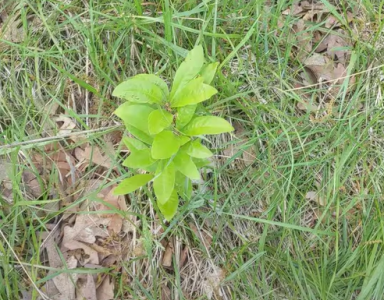
This is what quite a bit of the woods looks like. An oak savannah with mostly an herbaceous understory. With the new seedlings emerging all over the place, I am curious to what this place will look like in 10 years. I think we will try to leave sections as an oak savannah by burning more frequently in these parts, and allow others to have a more proper regeneration.
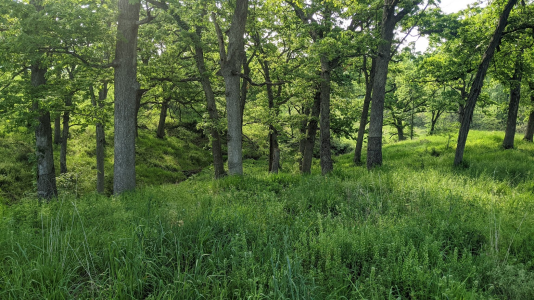
In terms of food plots, we are pivoting slightly. Originally, we were banking on ag field leftovers and fall food plots to cut down on labor since I live so far away. This past year was brutal in terms of deer activity after early November. We have a little over 50 acres of planted crops and once they are harvested in early to mid-fall, they are a ghost town. The past two falls have been very dry and fall food plots have been a bust, even with a drill. So I am moving towards grains (beans) and perennial greens, with still having the intention of broadcasting into select plots with brassicas, winter rye, and crimson clover in the fall. The expanded food plots are not at all for hunting, and are strictly just to help hold a few more deer later in the season.
For now, I am just calling this the cattle pond plot. I am still working on the mixture, but it will be mostly alfalfa with parts of it being a three-way mix of alfalfa, clover, and chicory. I think it will expand food available, without really affecting how we access the property to hunt.
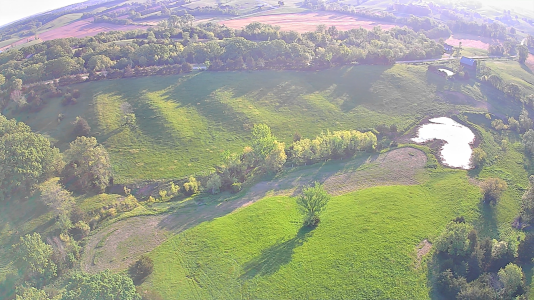
I sprayed out the winter rye and crimson clover in the ridgetop plot. We really need to get a crimper. This will be drilled with field beans in two weeks:

Finally, couldn't help but throw in a more scenic shot from the lastest drone flight:
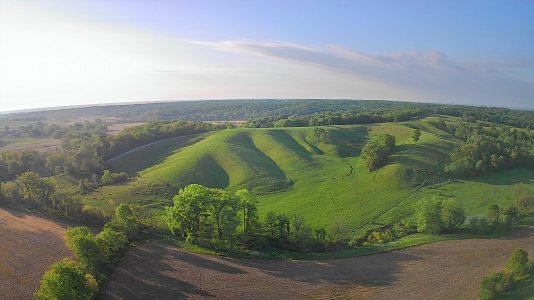
Pollinator planting:
I enrolled about 2.5 acres of marginal pasture into an EQIP pollinator program. The areas chosen were difficult to bail by our renter or already had quite a few native perennials beneficial to pollinators. I killed off the pasture last year and frost seeded a mix from Pheasants Forever this January. Of course, some of the cool-season grasses reared their head this spring, along with a bunch of annuals like ragweed. I am still somewhat confident that the plantings will be a success.
While waiting to see some of the seeded plants emerge, it was encouraging to see some of the native perennials survived the late season glyphosate apps. There were several of this cream false indigo that I am seeing for the first time.

This is probably insignificant for most, but seeing this has been a relief. This is a shingle oak seedling and is a still from a video I recorded showing all of the oak regeneration (mostly whites and shingle oaks, along with some reds). This has been a cattle farm for decades. There are almost no trees that are not mature, and it wasn't really until this spring that we started finding young oaks that have emerged since the cattle were pulled 3 years ago.

This is what quite a bit of the woods looks like. An oak savannah with mostly an herbaceous understory. With the new seedlings emerging all over the place, I am curious to what this place will look like in 10 years. I think we will try to leave sections as an oak savannah by burning more frequently in these parts, and allow others to have a more proper regeneration.

In terms of food plots, we are pivoting slightly. Originally, we were banking on ag field leftovers and fall food plots to cut down on labor since I live so far away. This past year was brutal in terms of deer activity after early November. We have a little over 50 acres of planted crops and once they are harvested in early to mid-fall, they are a ghost town. The past two falls have been very dry and fall food plots have been a bust, even with a drill. So I am moving towards grains (beans) and perennial greens, with still having the intention of broadcasting into select plots with brassicas, winter rye, and crimson clover in the fall. The expanded food plots are not at all for hunting, and are strictly just to help hold a few more deer later in the season.
For now, I am just calling this the cattle pond plot. I am still working on the mixture, but it will be mostly alfalfa with parts of it being a three-way mix of alfalfa, clover, and chicory. I think it will expand food available, without really affecting how we access the property to hunt.

I sprayed out the winter rye and crimson clover in the ridgetop plot. We really need to get a crimper. This will be drilled with field beans in two weeks:

Finally, couldn't help but throw in a more scenic shot from the lastest drone flight:

Hoytvectrix
5 year old buck +
Really good point! There is definitely an upside behind having fewer deer during the winter months. My parents farm is only a mile or two away with very high deer numbers. Deer find pretty much every single bare root seedling that is planted and unprotected. I have to tube every persimmon on their farm and I can get away with no tubing some on mine.Beautiful landscape on those drone shots.
Happy to see some hardwood regeneration happening for you! Sometimes lower deer density in winter can be a blessing until you get your plantings and shrubs established.
Hoytvectrix
5 year old buck +
We've had some success doing the same in a time crunch. More or less just pushing the butt-end of the bucket on the soil surface can lay very mature rye over. The glyphosate resistant second crop ends clearing any survivors anyways. It's pretty easy to end up overthinking food plots and feeling like they need to be perfect.If you have a front end loader you don't need a Crimper. Just put the bucket on float and crimp the rye. I often do it as I'm pulling the drill. Depending on how mature it is I'll be doing it late next week.
Nice looking place.
I'm sure you're like us with lots of time for standing around wondering what to do, but if the stars ever align it would be great to have you down our way to see it in person.
Hoytvectrix
5 year old buck +
It's been a minute since I gave an update. A lot has been going on but it hasn't felt like much has been worth documenting or sharing. This has certainly been a weird year. Probably too much water until August 12th and then the rain shut off for over a month. We haven't found any EHD deer yet this year, but the lack of deer on cameras all summer long sure is showing the effects last year's EHD had on the herd. So far, we have zero mature bucks between the three farms and are just hoping one or two show up. Regardless, I am assuming it will be a few years before the herd bounces back.
The first year for beans in food plots was nearly a bust. I am assuming this was a combination of poor planting depth, low bean population, and high browse pressure that limited how well they came up, because it certainly wasn't for lack of rain. The tallest plants only made it about a foot with a few pods on them. I overseeded brassicas and rye into them so hopefully there is some food for the deer. This plot is a little over an acre but effectively is only about a 1/4 acre because of the planting density.

One of the challenges with living 6 hours away is that things can get away from you in a hurry. In this case, the tractor initially broke down or it was too wet to brush hog this new plot. This plot was drilled in early June and had excellent emergence. The chicory, alfalfa, and clover are all still there, but along will all the weed seeds created by everything else that came up. Forced acceptance of "weeds" in plots is kind of comforting, actually. We knew about the extra sorghum sudan in the hopper but figured they would just get mowed off. I went back and forth on whether I should mow this plot or not. I think it might be kind of interesting to see how the deer use it.
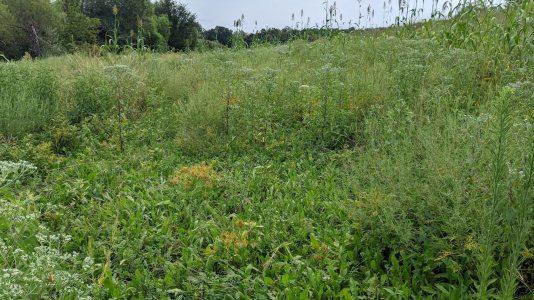
While we slowly transition the pasture ground to various cover types, I decided to drill in RC Big Rock switchgrass the first weekend in June to help screen in access paths for fall and winter hunting. This is the fourth variety/cultivar of switch I have planted and by far the fastest growing. This photo was taken in late August (3 months after drilling) and the RC Big Rock was about 4-5 feet tall. I think it put on another 6-12" since then.
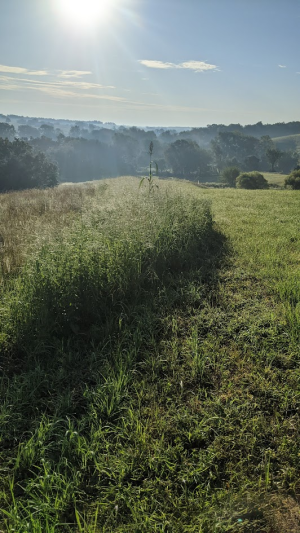
(The sorghum sudan seed that snuck in is 7-8 feet tall)
Some other wins have been chestnuts that I have been growing from seed and transplanting into 5 ft Miracle tubes or cages. The average 3 year old seedling is well out of the tubes. At this point, I either convert them over to cages or just prune inside the tubes if they have a decent form. I have somewhere around 50 chestnuts planted on this farm so far.
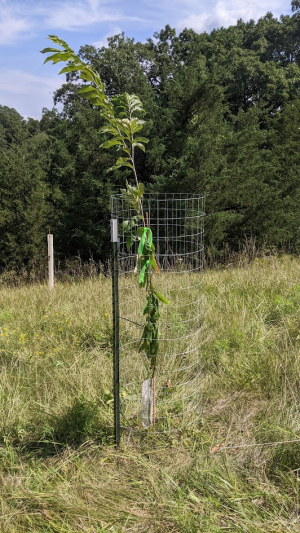
Ozark chinquapin (planted May 2023)
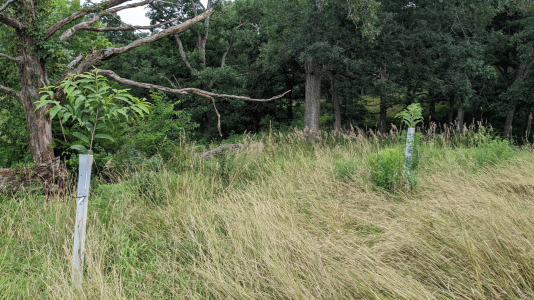
Skioka and Dunstan planted in May 2023. Chestnuts are open-air pollenated, so you technically don't know the genetics of the seedlings. However, some operations will sell the seeds under the cultivar name if the orchards are isolated.
This is a new chestnut orchard I just started. For the first year it will just have 15 trees but the plan is to work this up to 50 or so, with a 20' X 20' spacing that will be thinned down to 30 X 30. This isn't really intended to be a commercial orchard, but I will eventually graft over some of these seedlings to the better producing cultivars or varieties.
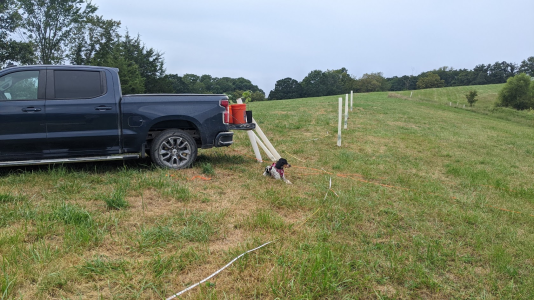
The dog in the photo above is also a new addition to the farm. She is an English Setter puppy I adopted from some family friends that went through some life changes and couldn't care for her anymore. For now she will just be a working companion around the farms, but I am hopeful I can train her as a bird dog. As we work on improving the habitat, we are seeing and hearing more quail around the property.
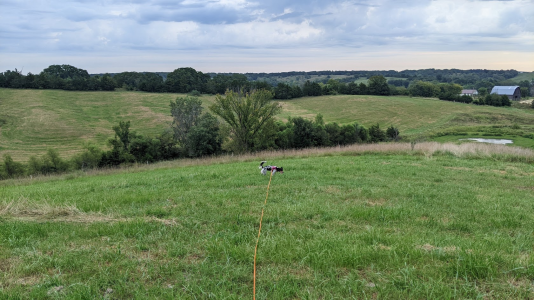
The first year for beans in food plots was nearly a bust. I am assuming this was a combination of poor planting depth, low bean population, and high browse pressure that limited how well they came up, because it certainly wasn't for lack of rain. The tallest plants only made it about a foot with a few pods on them. I overseeded brassicas and rye into them so hopefully there is some food for the deer. This plot is a little over an acre but effectively is only about a 1/4 acre because of the planting density.

One of the challenges with living 6 hours away is that things can get away from you in a hurry. In this case, the tractor initially broke down or it was too wet to brush hog this new plot. This plot was drilled in early June and had excellent emergence. The chicory, alfalfa, and clover are all still there, but along will all the weed seeds created by everything else that came up. Forced acceptance of "weeds" in plots is kind of comforting, actually. We knew about the extra sorghum sudan in the hopper but figured they would just get mowed off. I went back and forth on whether I should mow this plot or not. I think it might be kind of interesting to see how the deer use it.

While we slowly transition the pasture ground to various cover types, I decided to drill in RC Big Rock switchgrass the first weekend in June to help screen in access paths for fall and winter hunting. This is the fourth variety/cultivar of switch I have planted and by far the fastest growing. This photo was taken in late August (3 months after drilling) and the RC Big Rock was about 4-5 feet tall. I think it put on another 6-12" since then.

(The sorghum sudan seed that snuck in is 7-8 feet tall)
Some other wins have been chestnuts that I have been growing from seed and transplanting into 5 ft Miracle tubes or cages. The average 3 year old seedling is well out of the tubes. At this point, I either convert them over to cages or just prune inside the tubes if they have a decent form. I have somewhere around 50 chestnuts planted on this farm so far.

Ozark chinquapin (planted May 2023)

Skioka and Dunstan planted in May 2023. Chestnuts are open-air pollenated, so you technically don't know the genetics of the seedlings. However, some operations will sell the seeds under the cultivar name if the orchards are isolated.
This is a new chestnut orchard I just started. For the first year it will just have 15 trees but the plan is to work this up to 50 or so, with a 20' X 20' spacing that will be thinned down to 30 X 30. This isn't really intended to be a commercial orchard, but I will eventually graft over some of these seedlings to the better producing cultivars or varieties.

The dog in the photo above is also a new addition to the farm. She is an English Setter puppy I adopted from some family friends that went through some life changes and couldn't care for her anymore. For now she will just be a working companion around the farms, but I am hopeful I can train her as a bird dog. As we work on improving the habitat, we are seeing and hearing more quail around the property.

Attachments
Howboutthemdawgs
5 year old buck +
Love the update. Do you think the absence of a shooter is strictly from last years ehd or neighboring decision making?
Hoytvectrix
5 year old buck +
At this farm it is almost certainly because of EHD. Sure, this is a mast year for acorns. We have piles untouched acorns underneath of every white oak. But I've had cameras up the whole year and we have a fraction of the deer that have been in the area the last few years.Love the update. Do you think the absence of a shooter is strictly from last years ehd or neighboring decision making?
Talking with neighbors, nearly everyone was finding deer that had died in the late summer or fall. I think EHD is likely under reported because people have confusion with CWD.
Brian662
5 year old buck +
Nice update, things are looking good. RC Bigrock is a workhorse and unrivaled in the switchgrass world at the moment, IMO.
Crazy that you had all that EHD and low population issues and still couldn't grow soybeans? Seems more likely something went wrong with the planting like you mentioned. I've always used 1.25 to 1.5 rates (of convential ag beans) for soybean plots because I'm generally always 4 acres or less in plot size.
Crazy that you had all that EHD and low population issues and still couldn't grow soybeans? Seems more likely something went wrong with the planting like you mentioned. I've always used 1.25 to 1.5 rates (of convential ag beans) for soybean plots because I'm generally always 4 acres or less in plot size.
Hoytvectrix
5 year old buck +
Yeah, I think it was mostly a planting depth issue. We calibrated the drill and ran out in the correct acreage. This is an old cattle pasture on a ridgetop that has some compaction. I'll up the seeds/acre next year. I'm also likely going to use an E-fence because next year there won't be any other beans around.Nice update, things are looking good. RC Bigrock is a workhorse and unrivaled in the switchgrass world at the moment, IMO.
Crazy that you had all that EHD and low population issues and still couldn't grow soybeans? Seems more likely something went wrong with the planting like you mentioned. I've always used 1.25 to 1.5 rates (of convential ag beans) for soybean plots because I'm generally always 4 acres or less in plot size.
Even with the lower deer numbers it was a tiny plot right between the bedding areas and the main ag fields. These were even indeterminate beans. The fewer plants just couldn't keep up with the browsing that was taking place.
@Bill that's a good suggestion. Next year with the E-fence I will leave some unfenced just to check.
Similar threads
- Replies
- 75
- Views
- 3K

